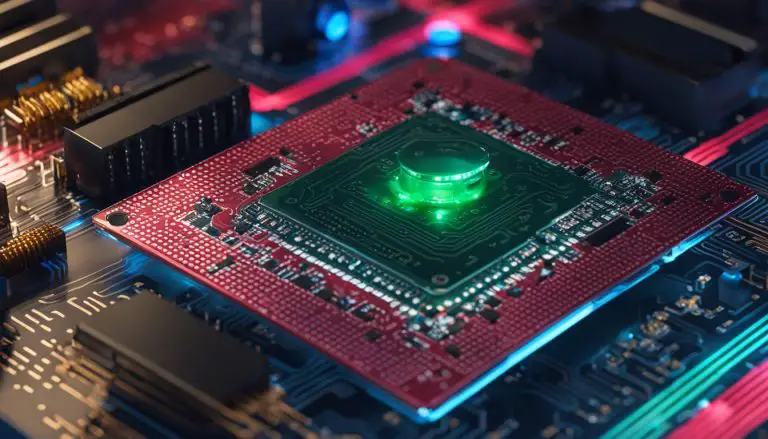Step-by-Step Guide: How to Update Kali Linux Easily
Kali Linux is a powerful operating system used for penetration testing, and it is crucial to keep it up to date for optimal security and performance. Regularly updating and upgrading Kali Linux ensures that you have the latest features, bug fixes, and security patches. In this step-by-step guide, I will walk you through the process of updating Kali Linux easily, ensuring that you can maintain a secure and efficient penetration testing environment.
Key Takeaways:
- Updating Kali Linux regularly is essential for optimal security and performance in penetration testing.
- The update process involves checking source list files, updating the package manager, and upgrading the system.
- Commands like apt upgrade, apt full-upgrade, and apt dist-upgrade are used to update and upgrade packages.
- Managing package dependencies and removing obsolete packages are important steps in the update process.
- Following these steps will help you keep Kali Linux up to date and maintain a secure penetration testing environment.
Why Update Kali Linux?
Regularly updating Kali Linux ensures that you have access to the latest features, bug fixes, and security patches, providing a more powerful and secure environment for your penetration testing needs. Keeping your Kali Linux system up to date is crucial for maintaining its effectiveness as a trusted tool in the field of cybersecurity.
One of the main reasons why updating Kali Linux is essential is the availability of new features. Developers constantly work on improving Kali Linux, introducing innovative tools and enhancements that can enhance the productivity and efficiency of your penetration testing activities. By staying up to date, you can take advantage of these new features, ensuring that you have access to the latest tools and technologies.
Furthermore, regular updates help address known bugs and vulnerabilities. Software, including operating systems like Kali Linux, is not immune to bugs and vulnerabilities. Security flaws can be exploited by malicious actors to gain unauthorized access or compromise the integrity of your system. Updates often include fixes for these vulnerabilities, closing potential security loopholes and strengthening the overall security of your Kali Linux installation.
Recommended Update Methods
To ensure a smooth and hassle-free update process, it is important to use the recommended update methods for Kali Linux. The most common method is to use the apt package manager, which allows you to easily update individual packages or upgrade the entire system. The apt-get update command updates the package list, while the apt-get upgrade command installs the latest versions of installed packages.
For a more comprehensive update, you can use the apt full-upgrade command. This command not only installs the latest versions of packages but also removes any obsolete or unnecessary packages that may be present on your system. It’s important to note that the apt full-upgrade command may remove certain packages that are no longer needed or have been replaced by newer versions.
Summary
Regularly updating Kali Linux is crucial for staying up to date with the latest features, bug fixes, and security patches. By using the recommended update methods, such as the apt package manager, you can ensure a smooth and secure update process. Updating Kali Linux helps to enhance its functionality, address vulnerabilities, and maintain a reliable and efficient penetration testing environment.
| Benefits of updating Kali Linux | Recommended Update Methods |
|---|---|
|
|
Checking Source List Files
Before updating Kali Linux, it is important to check the source list files to ensure that the correct repositories are enabled for fetching updates. These source list files contain the information about the repositories from where updates are fetched. By verifying and updating these files, you can make sure that you have access to the latest updates and security patches.
You can find the source list files in the
1 | /etc/apt/ |
directory. Open a terminal and navigate to this directory using the command:
Once you are in the
1 | /etc/apt/ |
directory, you can view the contents of the source list files using a text editor of your choice, such as nano or vim. For example, to view the main source list file, use the command:
In this file, you will see a list of repositories along with their URLs. Make sure that the URLs are correct and that the repositories are enabled by removing any comment symbols (#) in front of the lines. Save the changes and exit the text editor.
After checking and updating the source list files, you are now ready to proceed with updating and upgrading Kali Linux.
| Command | Description | ||
|---|---|---|---|
|
Navigates to the apt directory | ||
|
Opens the main source list file for editing |
Updating the Package Manager
Updating the package manager in Kali Linux is crucial for obtaining the latest package information and maintaining a well-functioning system. The package manager is responsible for managing software installations and updates, ensuring that your system stays up to date with the most recent releases.
One of the best practices for updating Kali Linux is to regularly run the following command:
This command fetches the latest package information from the repositories enabled on your system. It ensures that you have access to the most recent software versions available in the Kali Linux repositories.
Once the package information is updated, it is recommended to upgrade the installed packages by using the command:
This command updates the installed packages to their latest versions, ensuring that you benefit from bug fixes, feature enhancements, and security patches. It is important to note that the
1 | apt upgrade |
command only updates the packages but does not remove any existing installations. If you want to remove any installed packages that are no longer needed, you can use the
1 | apt full-upgrade |
command instead.
Updating the Package Manager: Best Practices
- Always run
1sudo apt update
before performing any updates or upgrades to ensure you have the latest package information.
- Regularly check for updates and upgrades to keep your Kali Linux system secure and up to date.
- Review the package information and update logs to understand the changes and improvements made in each update.
- Make sure to have a stable internet connection to avoid any interruptions during the update process.
- Back up your important data before performing any system updates or upgrades to avoid any potential data loss.
By following these best practices, you can ensure that your Kali Linux system is always running on the latest package versions, benefiting from the latest features and security enhancements.
| Command | Description | ||
|---|---|---|---|
|
Updates the package information to the latest versions available in the repositories. | ||
|
Updates the installed packages to their latest versions. | ||
|
Upgrades installed packages, removing any unnecessary packages if needed. | ||
|
Removes obsolete packages to free up disk space. |
Keeping Kali Linux up to date is essential for maintaining a secure and efficient penetration testing environment. By regularly updating the package manager and following best practices, you can ensure that your Kali Linux system remains up to date with the latest software releases and security patches.
Upgrading the System
Now that the package manager is up to date, it’s time to upgrade the Kali Linux system itself for enhanced performance and security. The process is straightforward and can be done using the appropriate commands.
To start, open the terminal and enter the following command:
This command will update all the installed packages without deleting anything previously installed. It’s a safe way to ensure that all the software on your system is up to date.
Once the upgrade process is complete, you can proceed with the system upgrade. To do this, enter the following command:
Unlike the previous command, apt full-upgrade may remove already installed packages if necessary to ensure a smooth upgrade. It intelligently handles changing dependencies, ensuring that your system remains stable and functional.
By following these steps, you can keep your Kali Linux system up to date, benefiting from the latest features, bug fixes, and security patches. Remember to regularly check for updates and upgrades to maintain a secure and efficient penetration testing environment.
| Command | Description | ||
|---|---|---|---|
|
Update installed packages | ||
|
Upgrade the Kali Linux system |
Managing Package Dependencies
When updating Kali Linux, it is crucial to manage package dependencies effectively to ensure a smooth and error-free update experience. Package dependencies refer to the relationships between different software packages, where some packages rely on specific versions of other packages to function properly. Failing to handle these dependencies correctly can result in compatibility issues and potential system errors.
To effectively manage package dependencies in Kali Linux, the apt dist-upgrade command is a reliable tool. This command goes beyond a regular upgrade and intelligently handles changing dependencies by removing or installing additional packages as necessary. It ensures that all required dependencies are properly updated or installed, resulting in a more stable and functional system.
Using the apt dist-upgrade command is considered a best practice when updating Kali Linux. It not only ensures that all packages are updated to their latest versions, but also takes care of any conflicts or issues that may arise due to changing dependencies. By using this command, users can have peace of mind knowing that their system is up to date and functioning optimally.
| Command | Description |
|---|---|
| apt dist-upgrade | Upgrade the system, intelligently handling changing dependencies. |
By effectively managing package dependencies through the apt dist-upgrade command, users can avoid potential issues and ensure a seamless update process in Kali Linux. This not only enhances the security and stability of the system, but also allows users to take full advantage of the latest features and improvements available.
Removing Obsolete Packages
To keep your Kali Linux system optimized and clutter-free, it’s important to remove obsolete packages that are no longer needed after the update process. Doing so not only frees up valuable disk space but also helps maintain a clean and efficient system. Thankfully, the apt autoremove command makes this process quick and easy.
When you run the apt autoremove command, it scans your system for packages that were automatically installed as dependencies but are no longer required by any other installed packages. These are typically packages that were installed during the update or upgrade process but are no longer necessary.
It’s good practice to run the apt autoremove command periodically, especially after performing system updates or upgrades. This ensures that any lingering obsolete packages are promptly removed, preventing them from taking up unnecessary disk space or causing potential conflicts with new software installations.
| Command | Description |
|---|---|
| apt autoremove | Removes obsolete packages that are no longer required by any other installed packages. |
Note: Before running the apt autoremove command, it’s essential to review the list of packages that will be removed. While the command is generally safe to use, it’s always a good idea to double-check to ensure no critical packages are inadvertently removed.
By following this best practice, you can ensure a streamlined and efficient Kali Linux system by removing unnecessary packages that are no longer needed. Remember to periodically run the apt autoremove command after performing updates or upgrades to maintain the cleanliness and performance of your system.
Conclusion
Regularly updating Kali Linux is a crucial aspect of maintaining a secure and efficient penetration testing environment. By following the step-by-step guide provided, you can easily keep your system up to date.
Updating Kali Linux is important for several reasons. First, it ensures that you have access to the latest features and improvements in the operating system. These updates can enhance your workflow and provide you with new tools and capabilities for your penetration testing tasks.
Furthermore, updating Kali Linux allows you to stay on top of bug fixes and security patches. The developers behind Kali Linux are constantly working to identify and fix vulnerabilities, and by updating your system, you can ensure that you are protected against the latest threats.
To update Kali Linux, follow the step-by-step guide provided in this article. Start by checking the source list files to ensure that the correct repositories are enabled for updates. Then, update the package manager, which is responsible for managing software installations and updates.
Next, upgrade the system using the appropriate commands to ensure a smooth and successful update. During this process, it is important to manage package dependencies and remove any obsolete packages using the apt dist-upgrade and apt autoremove commands respectively. By following these best practices, you can keep your Kali Linux system up to date and maintain a clean and efficient environment for your penetration testing needs.
FAQ
Why is it important to regularly update Kali Linux?
Regularly updating Kali Linux is crucial for ensuring the security and performance of the operating system. Updates often include bug fixes, security patches, and new features that help protect against vulnerabilities and keep the system running smoothly.
How can I check the source list files in Kali Linux?
To check the source list files in Kali Linux, you can navigate to the “/etc/apt/sources.list” directory. This directory contains the repository sources that are used for fetching updates. Make sure the correct sources are enabled to ensure you receive the latest updates.
How do I update the package manager in Kali Linux?
Updating the package manager in Kali Linux is a simple process. You can use the “apt update” command to update the package lists without modifying any installed packages. This step ensures that the package manager has the latest information about available updates.
What is the best way to upgrade the Kali Linux system?
The recommended way to upgrade the Kali Linux system is by using the “apt upgrade” command. This command allows you to update all installed packages without removing anything, ensuring a smooth and seamless upgrade process.
How do I handle package dependencies during the update process?
When updating Kali Linux, it is important to handle package dependencies properly. The “apt dist-upgrade” command is designed to intelligently handle changing dependencies. It ensures that packages are upgraded correctly by resolving any conflicts or discrepancies.
How can I remove obsolete packages in Kali Linux?
To remove obsolete packages in Kali Linux, you can use the “apt autoremove” command. This command identifies and removes any packages that are no longer needed, freeing up disk space and maintaining a clean and efficient system.
- About the Author
- Latest Posts
Janina is a technical editor at Text-Center.com and loves to write about computer technology and latest trends in information technology. She also works for Biteno.com.






